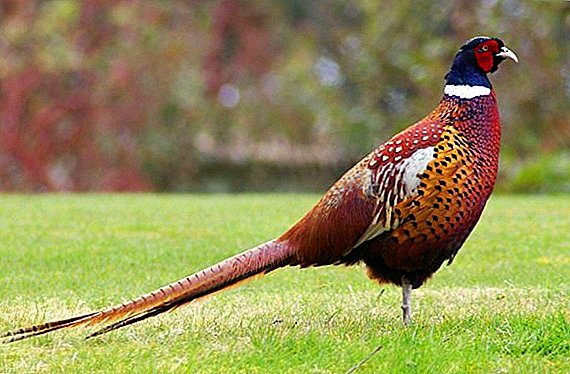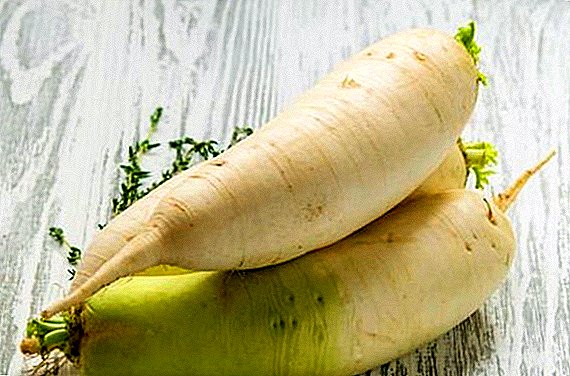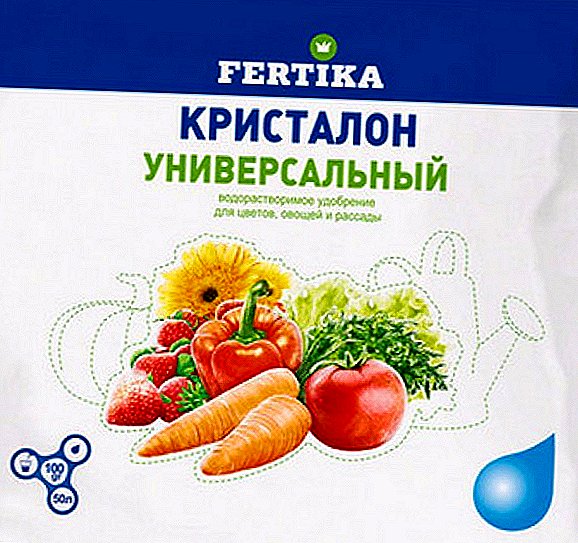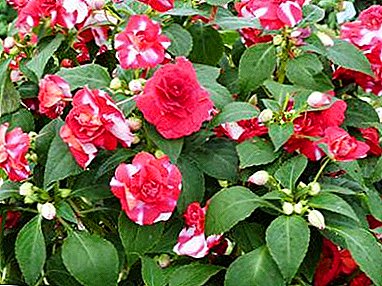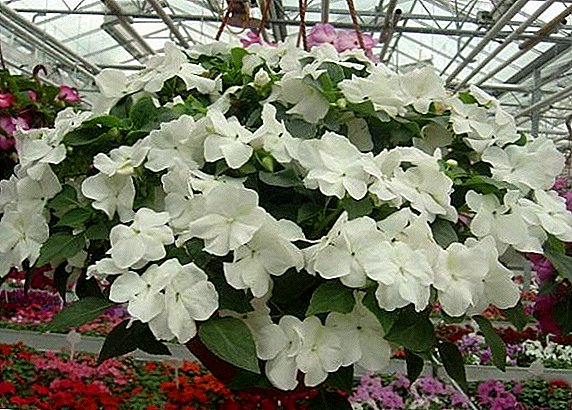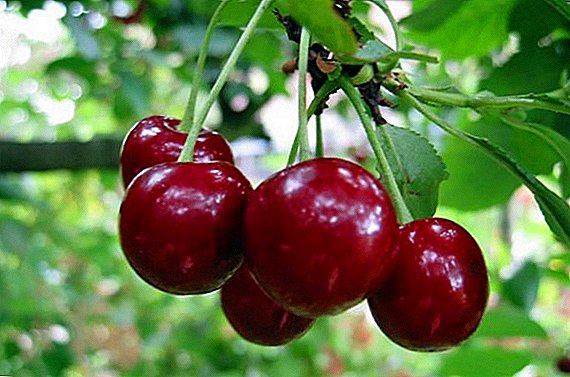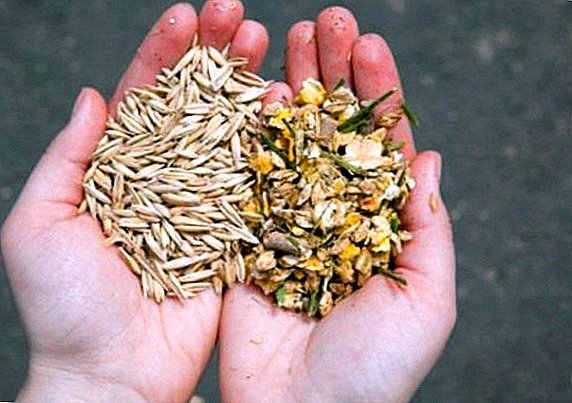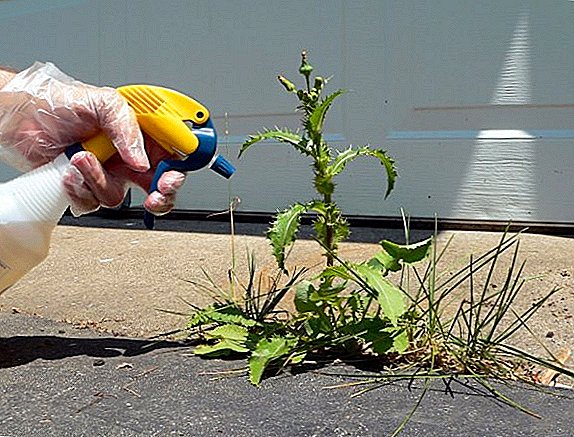 Among garden crops in the open ground first gets onions. Due to its unpretentiousness, it can be planted at a temperature of only 10-12 ° C. Early-maturing varieties and hybrids are best adapted to such conditions. Among them, well-known variety of onion "Corrado". About its features, technology, landing, and will be discussed in our article.
Among garden crops in the open ground first gets onions. Due to its unpretentiousness, it can be planted at a temperature of only 10-12 ° C. Early-maturing varieties and hybrids are best adapted to such conditions. Among them, well-known variety of onion "Corrado". About its features, technology, landing, and will be discussed in our article.
Variety description
Bulb "Corrado" - a rounded flat shape, covered with a dense, double, golden-yellow or golden-brown husk. Peel very tightly envelops the internal scales, which significantly increases the quality of onion and preserves its presentation. The leaves are hollow, with a two-row arrangement (each subsequent grows out of the previous sinus), reach a length of about 30 cm. They are painted in a bluish-green color. The onion planted on seeds produces a long (up to 1.5 cm) hollow arrow, at the end of which an inflorescence is formed. At the end of the flowering period, black triangular seeds ripen in boxes. 
Advantages over other varieties:
- high yield;
- good keeping quality;
- resistant to bolting;
- powerful root system;
- high resistance to diseases and pests;
- high maturity (96-100%);
- double husks.
Disadvantages:
- does not tolerate low temperatures, so it is best to grow in southern and middle latitudes.
Did you know? The prefix F1 in the name of the variety "Corrado F1" says that this variety is a heterotic hybrid of the first generation, obtained as a result of unrelated crossing. This hybrid has increased vitality, productivity, growth, resistance to diseases and pests.
Characteristics of onions and yield
The variety is medium early. According to one source, harvesting can be carried out 93-97 days after germination. Other sources say that it should take 100-105 days. Perhaps this discrepancy in terms is due to the climate zone in which the culture grows. In warm latitudes, it matures faster than in cold ones. "Corrado" is characterized by high yields: from 1 square. m can collect about 8 kg of onions. And if winter crops were produced, then from 1 acre the crop reaches 350 kg. 
Characteristic bulbs:
- weight: 110-130 g;
- shape: rounded flat;
- taste: medium sharpness.
Selection of planting material
Usually onions are grown from sevka. It can either be prepared by yourself or purchased at the store. If you chose the Corrado grade for the first time, you should take into account some of the nuances of the selection of sets. There are several types of seeding, differing in size.
Grow slizun, shallot, batun, chives, and fragrant and multi-tiered onions.
Each size is suitable for a specific landing period:
- the smallest (8-14 mm) - ideal for winter planting;
- medium (14-21 mm) - suitable for winter and spring planting;
- large (21-24 mm) - suitable for a podzimny landing on a feather, and during spring planting will give a good harvest if the landing periods are properly observed;
- large (24-30 mm) - destination, as in the previous variety, but this sevke more affordable;
- samples (30-40 mm) - onion sets for greens.
Important! Sevok should be stored in a ventilated warm place (10-15 ° C) and at a humidity of 70-75%. Do not allow temperature jumps, otherwise the seed will shoot arrows.Choosing seeds is a little easier than planting. In this case, you should be guided by the rule: “proven” means qualitative. If you buy seeds for the first time, give preference to well-known producers. It is also better to shop in specialized stores, rather than in the markets. For selected seeds, also check the expiration date shown on the label. When you come home, be sure to check seed germination.
 To do this, take a dozen seeds from the package and put them in a glass or a container for seedlings of 50-100 ml, covered with filter paper or gauze. Top with a little water, so that the seeds are slightly soaked. Capacity clean in heat for 7-10 days. Then count the number of germinated seeds. Germination should be at least 50%.
To do this, take a dozen seeds from the package and put them in a glass or a container for seedlings of 50-100 ml, covered with filter paper or gauze. Top with a little water, so that the seeds are slightly soaked. Capacity clean in heat for 7-10 days. Then count the number of germinated seeds. Germination should be at least 50%.Growing conditions
Under the onion bed in the plot, choose a place on a small hill, well lit by the sun and sheltered from cold winds. Draft culture does not like drafts. Southerners and residents of the temperate zone can plant the Corrado variety for the winter in October-November, when the temperature of the soil reaches 5 ° C. Summer residents of colder latitudes should wait for spring, when the temperature overcomes a barrier of 10-12 ° C. The optimal temperature indicators for ripening onions - 18-20 ° C. At higher temperatures and lack of moisture, taste deteriorates, and at low temperatures, growth slows down.
Learn how to grow onions, what is rokambol, Indian and viper onions.
Soil and fertilizer
"Corrado" perfectly take root on any soil. But if you want to get a good harvest, plant a crop in loose, drained, nutritious loamy soil. Acidity should be neutral. If there is a need for soil deoxidation, then this should be done 2-3 years before sowing onions with the help of lime. Humus also needs to be made in advance (1.5-2 years).  Ideal predecessors - early cabbage, zucchini, cucumbers, tomatoes, early potatoes. Onions after onions can be planted only after 3-4 years. Suitable neighbor - carrots. These cultures perfectly protect each other from pests. Do not recommend planting onions after legumes (peas, beans).
Ideal predecessors - early cabbage, zucchini, cucumbers, tomatoes, early potatoes. Onions after onions can be planted only after 3-4 years. Suitable neighbor - carrots. These cultures perfectly protect each other from pests. Do not recommend planting onions after legumes (peas, beans).
Growing from seed to seedlings at home
Growing seedlings of garden crops in our latitudes allows not only to get a harvest on time, but also to grow a more viable crop. Onion varieties "Corrado" - no exception.
Seed preparation
If you checked the seeds for germination, then their preparation should begin a couple of days before sowing. If the seeds have not passed the test, then you will need about 2 more weeks, and you may have to carry out the replacement of the seed material (germination test is described above). Quality material must be heated. To do this, in a small container, type water at a temperature of 50 ° C. Immerse the seeds in it for 20 minutes, after which cool the planting material under running water for 2-3 minutes.  Further, if the manufacturer did not indicate that the seed was disinfected, the procedure must be performed independently. Soak the seeds for 24 hours in a weak solution of potassium permanganate. After that you can soak in a growth accelerator, such as "Ecopin", for about 3 hours. Wrap inoculated seed in a damp cloth and keep warm. Every day the seeds must be checked for the presence of sprouts. When 3-5% of seeds appear sprouts, they can be planted in the soil.
Further, if the manufacturer did not indicate that the seed was disinfected, the procedure must be performed independently. Soak the seeds for 24 hours in a weak solution of potassium permanganate. After that you can soak in a growth accelerator, such as "Ecopin", for about 3 hours. Wrap inoculated seed in a damp cloth and keep warm. Every day the seeds must be checked for the presence of sprouts. When 3-5% of seeds appear sprouts, they can be planted in the soil.
It will be interesting to know - how to grow onions from seeds.
Content and location
Sowing can be done either in cups or in boxes designed for seedlings. Their depth should not exceed 6-9 cm. There should be drainage holes at the bottom. As a soil, you can use a purchased substrate for vegetable crops or prepare the mixture yourself. To do this, take the sheet and sod land, humus, river sand in the ratio of 1: 1: 1.5: 0.5.
The container with future seedlings is covered with a film and placed in a warm place. When shoots appear, seedlings are moved to a lighted place and the film is removed. The room temperature should be maintained at 15-16 ° C.
Seed planting process
In the open ground, seedlings are usually planted when frosts recede (approximately April-May). By this time, shoots should be 50-60 days. From this it is necessary to build on when calculating the date of sowing. Prepared seeds are planted in boxes with tweezers.  Each germinated seed is carefully placed in small cavities (grooves) in the soil at a distance of 1.5 cm from each other. Top sprinkled with soil, covered with foil and clean in a warm place. Until seedlings appear, the temperature in the room should be 18-25 ° C. After it is lowered to 14-16 ° С, the film is removed and the boxes are moved to a sunny place. These manipulations are necessary so that the seedlings do not stretch out.
Each germinated seed is carefully placed in small cavities (grooves) in the soil at a distance of 1.5 cm from each other. Top sprinkled with soil, covered with foil and clean in a warm place. Until seedlings appear, the temperature in the room should be 18-25 ° C. After it is lowered to 14-16 ° С, the film is removed and the boxes are moved to a sunny place. These manipulations are necessary so that the seedlings do not stretch out.
Seedling care
In order for the seedlings to grow well, it must be regularly watered with settled water at room temperature. Watering should be carried out when drying the top layer of soil.
Important! Try to prevent drying or, on the contrary, soil sticking.Needs young onions and feeding. It should be carried out before planting seedlings in the ground. Feeding should be 2, with an interval of 14 days. As a fertilizer, use a solution of 20 g of superphosphate, 5 g of potassium chloride, 10 g of urea, diluted in 10 liters of water. You can use a more simple feeding: chicken litter, diluted in water in proportions of 1 to 10.

Transplanting seedlings to ground
We have already noted that planting seedlings in open ground is carried out at the end of frosts. By this time, a young onion should form 3-4 true leaves. Weeks 2 weeks before the estimated date of planting the seedlings need to be hardened. For this, seedlings are carried out on the balcony or on the street. The first procedure should not last more than 10-15 minutes. Each subsequent day, its duration should be gradually increased.
Read also about how to fertilize onions.
Landing is carried out in the afternoon. The soil with seedlings is moistened and each seedling is carefully taken out of the ground. If its root system is too long, it should be shortened by a third. Grooves should be made at a distance of 30 cm one from one. In them with an interval of 5 cm planted seedlings. It is buried 1 cm into the soil. Everything is plentifully watered and mulched with peat.
Cultivation from sevka in open ground
This method of planting culture is more familiar to us. But he has his own peculiarities.
Site selection and soil preparation
As mentioned earlier, the onion "Corrado" loves nutritious, loose, loamy soil and prefers to grow on a hill, in a place sheltered from the winds. Usually sevka planted in open ground. Greenhouses are used only when it is necessary to obtain greens during the whole spring and autumn period. If an autumn planting is planned, then the soil should be mulched with foliage, peat and humus, forming a layer of 8-10 cm.  This will protect the soil from freezing. Weeks 2 weeks before the onset of cold weather, mulch is removed and sowing is planted in the soil. Above the ground again need to mulch. When spring planting, the mulch laid out in autumn is raked, the soil is loosened with a rake and grooves are made. They put onions and cover with a special material.
This will protect the soil from freezing. Weeks 2 weeks before the onset of cold weather, mulch is removed and sowing is planted in the soil. Above the ground again need to mulch. When spring planting, the mulch laid out in autumn is raked, the soil is loosened with a rake and grooves are made. They put onions and cover with a special material.
Seed preparation
Approximately 1 month before the intended landing of the crop, planting material needs to be sorted out. It is sorted by size, clean spoiled, dried, injured onions. The finished material undergoes a drying procedure in a warm dry room without drafts. Dried sevok necessary to warm up, so that he did not let the arrows ahead of time. You can warm under the battery or in the sun.
Important! Soak and trim the neck of the bulbs is not necessary.The first 2 weeks should be maintained at a temperature of 20 ° C for warming up. After, for 8-10 hours, place the set in conditions with a temperature of 40 ° C. It is important not to overdry the seed. Before planting, you also need to disinfect the sev. Onions are immersed in a solution of copper sulfate (30 g per 10 l of water) for 2 hours. Then the onions are washed with water.

The process of planting sevka in the ground
The seedling is planted in the beds on which grooves are made in advance. The depth of the furrow should be the size of the set. If the bulb diameter is 1 cm, then the depth of the groove should be about 4 cm. The grooves should be made at a distance of 20-30 cm one from one. The bulb is buried 3-5 cm in the soil. There should be 5-10 cm between the chains.
Watering
The first abundant watering should be carried out immediately after planting the culture. Further, approximately within 2 months, it is necessary to moisten crops 1-2 times a week. Watering is better with settled water at room temperature. If a dry season has arrived, the frequency of watering should be increased. Adjust the interval yourself, based on the condition of the soil. Somewhere in the middle of the vegetative period, the frequency of watering is gradually reduced. 2-3 weeks before harvesting, watering is stopped.
Soil loosening and weeding
Loosening the soil is performed during the removal of weeds. And weeds should be removed regularly (once a week), otherwise they will interfere with the normal development of culture. It is not necessary to spud onions while loosening the soil. The procedure should be carried out in the evening or morning time (before the onset of heat) in dry weather.
Top dressing
With proper soil preparation, fertilizing may not be necessary. But if you notice a violation in the growth of culture, the appearance of yellowness on the foliage, then you need to make nutrient mixture in the ground. The easiest way to prepare a mixture of ammonium nitrate (10 g) and potassium salt (15 g) and dissolve it in 1 bucket of water. This will be enough to feed 1 square. m beds. You can also make ash. 
Pests, diseases and prevention
The variety is resistant to diseases and pests. Therefore, if all the rules of cultivation are observed, the culture will be a good harvest.
Harvesting and storage
The vegetative period of the onion "Corrado" is 93-105 days. After this period of time, counted from shoots, you can harvest. Onion ripening will testify:
- cessation of new leaf growth;
- dropping foliage to the ground and its gradual dying off (yellowing);
- thinning and softening of onion neck.
 In the process of drying the onions must be turned and mixed. Drying time - 1-2 weeks. The crop is stored in a ventilated room at a temperature of 15-20 ° C in wooden boxes. Under the conditions of storage, the onion of this variety can last for a new crop, retaining all its properties.
In the process of drying the onions must be turned and mixed. Drying time - 1-2 weeks. The crop is stored in a ventilated room at a temperature of 15-20 ° C in wooden boxes. Under the conditions of storage, the onion of this variety can last for a new crop, retaining all its properties.Possible problems and recommendations
The main problem of most varieties of onion - rifle - "Corrado" is practically devoid. But he remains different: yellowing of the foliage, the appearance of bitterness, the fading of the greenery, the twisting of the feathers.
- Yellowing of the foliage can occur due to a lack of nutrients in the soil or failure to maintain the plant. It is necessary to feed the culture with a nutrient substrate and normalize the regime of watering, weeding, and loosening.
- There is bitterness in hot dry weather. These conditions provoke the accumulation of glycosides in the bulb, which give bitterness. Therefore, in the dry season, it is necessary to increase the frequency of irrigation and feeding of the crop.
- Greens tarnish with a lack of nitrogen in the soil. To normalize the level of the element in the ground should prepare a solution of urea (10-15 g per 5 liters of water).
- Feathers curl with a lack of potassium. Making up the potassium salt solution (5-7 g per 5 l of water) will help to compensate for the loss of the element.
Did you know? Cutting in the eyes and tearing when cutting onions are caused by amino acids that are released from deformed vegetable cells. Interacting with enzymes, they are converted to acid, and then - in the gas. The latter, getting on the mucous membrane of the eyes and binding to the tear fluid, forms sulfuric acid, which causes irritation.
 Onion "Corrado" - a high-yielding mid-season hybrid, confidently gaining a leading position among similar varieties. Its good quality and good taste make it easy to stock up on vegetables for the whole winter. This is facilitated by the ease in growing crops.
Onion "Corrado" - a high-yielding mid-season hybrid, confidently gaining a leading position among similar varieties. Its good quality and good taste make it easy to stock up on vegetables for the whole winter. This is facilitated by the ease in growing crops.

